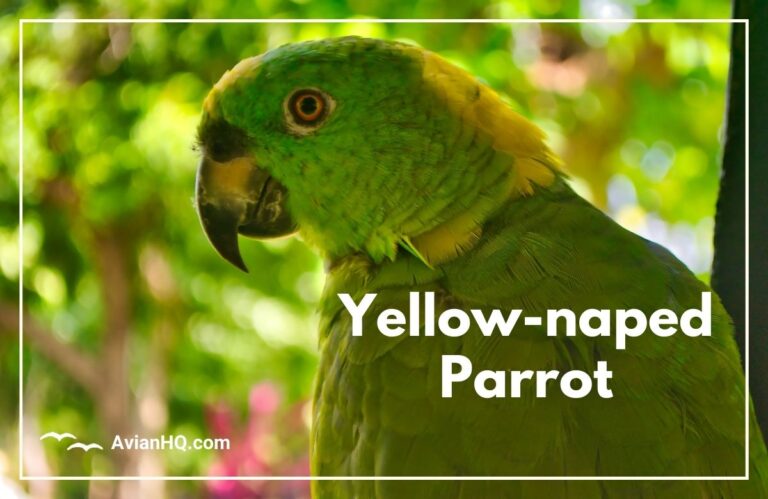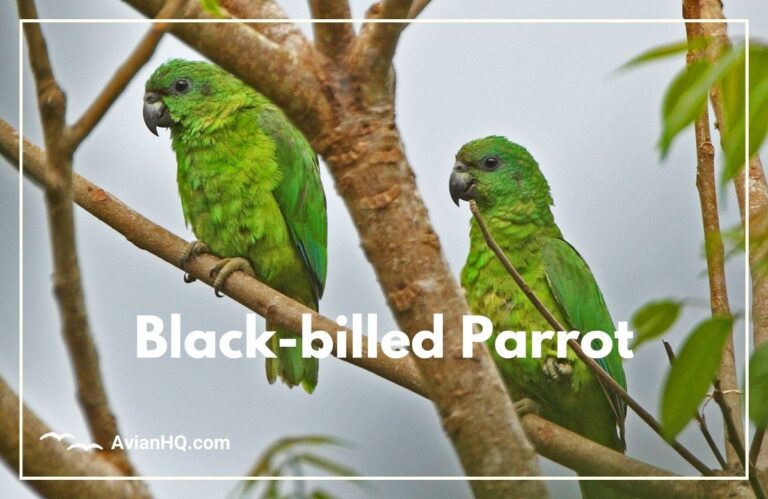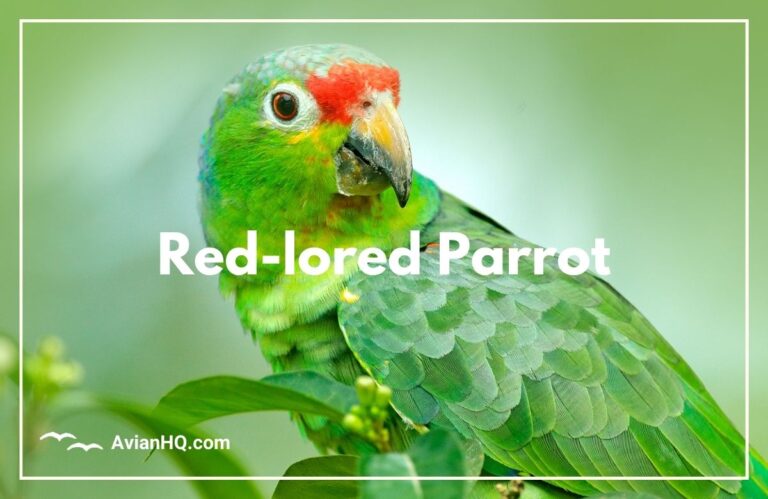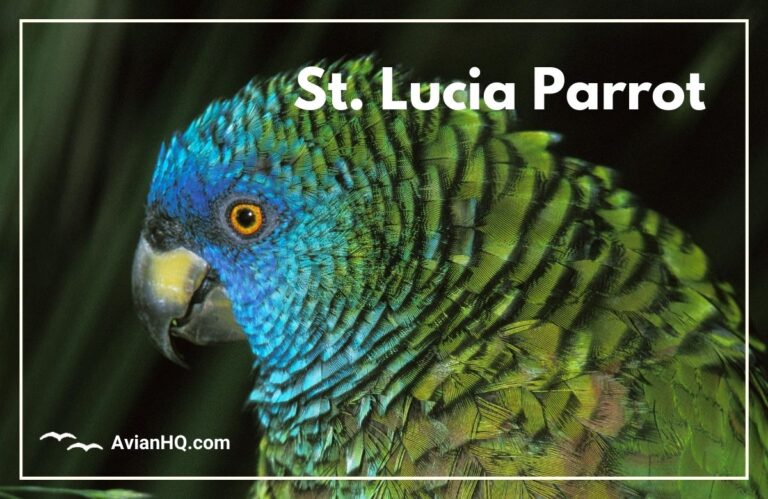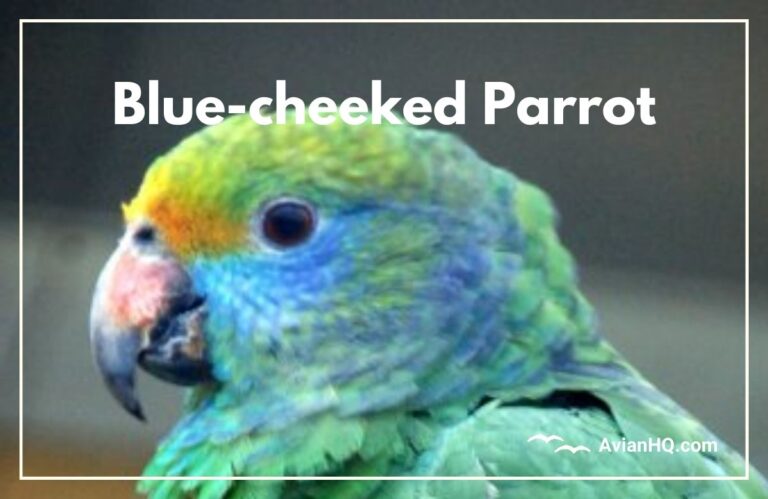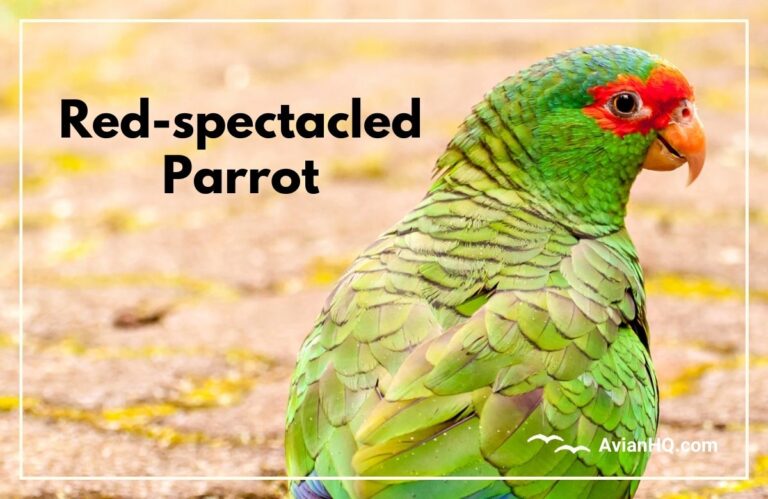Puerto Rican Parrot (Amazona vittata)
As you explore the lush rainforests of Puerto Rico, you may catch a glimpse of vibrant green feathers and hear a distinctive squawking call. Look closely up in the canopy, and you just might spot the Puerto Rican Parrot, also known as the Iguaca. Measuring about 11-12 inches (28-30 cm) long and weighing 8-11 ounces (250-300 g), this parrot is a highly endangered species found only in El Yunque National Forest and Rio Abajo Forest.
The Puerto Rican Parrot has faced immense challenges over the last century. Once abundant and ranging across Puerto Rico and its offshore islands, the parrot population plummeted from around one million birds in the 1800s to just 13 individuals in 1975 due to destruction of forests for agriculture and collection of chicks for the pet trade. Intensive conservation efforts since then have slowly helped stabilize numbers, but the species remains critically endangered.
As the only native parrot in Puerto Rico and a culturally iconic species, the fate of the Puerto Rican Parrot is closely intertwined with the island itself. Joining recovery efforts in the treetops gives you a unique chance to save this rare bird and preserve Puerto Rico’s natural heritage for future generations. Tracking the parrots’ range, diet, breeding habits, and population trends provides key insights to guide protection strategies for the species.
So grab your binoculars and get ready for a rewarding quest to understand the natural history of the Puerto Rican Parrot and support its continued survival! The brilliant green Iguaca still has a fighting chance as long as knowledgeable naturalists and conservationists like you remain dedicated to the cause.
History and Taxonomy
The Puerto Rican Parrot’s scientific name is Amazona vittata. The genus name Amazona refers to the group of mainly Caribbean and Central American parrots this species belongs to, while vittata means “banded” in Latin, describing the parrot’s scaled plumage pattern.
French naturalist Comte de Buffon first described the Puerto Rican Parrot back in 1780, though he mistakenly believed his specimen came from the French colony in Haiti rather than Puerto Rico. Buffon included an illustration of the species in his comprehensive natural history series Histoire Naturelle des Oiseaux.
Today, taxonomists recognize two subspecies of the Puerto Rican Parrot:
- A. v. vittata – The nominate subspecies still surviving in Puerto Rico
- A. v. gracilipes – A extinct subspecies that once inhabited nearby Culebra Island
The evolutionary origins of the Puerto Rican Parrot trace back to the mainland neotropical parrots in Central and South America. This ancestral stock likely colonized the Caribbean islands in one or more dispersal events across open water gaps. The parrot then differentiated into an endemic species found only in Puerto Rico and its satellite islands. Recent DNA studies suggest its closest living relatives are the Cuban Parrot (Amazona leucocephala) and Hispaniolan Parrot (A. ventralis) on neighboring islands.
Physical Appearance
The Puerto Rican Parrot measures about 11-12 inches (28-30 cm) long and weighs between 8-11 ounces (250-300 grams). Its plumage is mostly bright green above with a red forehead and distinctive white eye rings. The primary flight feathers on the wings have a deep blue color, visible when the parrot is flying. The tail and wing undersides also have blue feathers mixed in.
This parrot has a yellowish-green underside and belly region. The chin may have some darker scaling. The bill is grayish-white and the eyes are brown. Legs and feet are pinkish flesh colored.
Male and female Puerto Rican Parrots have identical external appearance, without sexual dimorphism in size or plumage. Juvenile birds resemble adults but may show some light gray scaling before their first molt.
The extinct subspecies A. v. gracilipes found on Culebra Island was similar overall but may have averaged slightly smaller in body size. Plumage markings were likely almost identical. No living specimens of this extinct form remain for direct comparison.
Habitat and Distribution
The Puerto Rican Parrot evolved as an endemic species found only in Puerto Rico and several nearby satellite islands in the northeastern Caribbean. Its native range historically encompassed the entire mainland island of Puerto Rico.
In past centuries, the parrots occupied all the various forest habitats on the island, from mangrove swamps up to high elevation cloud forests, spanning rainforest, semi-arid, and montane ecological zones. Recorded elevations ranged from sea level up to around 2000 feet (600 meters).
Today the species only persists in two remnant population areas in north-central Puerto Rico:
- El Yunque National Forest, at elevations of 1000-2700 feet (300-800 meters)
- Rio Abajo Forest Preserve, at 1300-2300 feet (396-823 meters) elevation
Reintroduced populations have also been established through aviary breeding and release programs on the islands of Culebra and Vieques.
The extinct subspecies A. v. gracilipes was found only on neighboring Culebra Island, 17 miles (27 km) east of the Puerto Rican mainland. It disappeared sometime in the early 20th century due to deforestation and hunting pressures.
Diet and Feeding
As a tropical forest-dwelling parrot, the Puerto Rican Parrot naturally feeds on a diverse herbivorous diet of seeds, fruits, flowers, leaves, buds, and bark gathered from trees. Their beaks and tongues are specially adapted for manipulating this vegetarian fare.
Documented food plants consumed include tabonuco (Dacryodes excelsa), sierra palm (Prestoea montana), caimitillo verde (Micropholis garciniaefolia), cupey de altura (Clusia gundlachii), and laurel sabino (Magnolia splendens) among over 60 species.
Puerto Rican Parrots use their strong flight ability to forage widely across their forest habitat, gathering different ingredients from multiple trees. They often feed in mated pairs, working together to maximize their dietary diversity.
The parrots directly grasp or bite off pieces of softer vegetation like flowers, fruits, leaves and bark with their tapered bills. For harder nuts and seeds, they may hold food items with their feet and shred them open with their bills.
Most foraging takes place high in the forest canopy, anywhere from around 20 to 60 feet (7 to 15 meters) above the ground. But Puerto Rican Parrots will readily take advantage of more easily accessed cultivated fruits and grains at lower levels when available, where these human foods supplement gaps in native resources.
Breeding and Reproduction
The Puerto Rican Parrot breeds between February and July, during the drier months in its tropical forest habitat. These parrots are monogamous, pairing up with a single partner for life. The bond between mates is very strong.
Courtship displays involve coordinated bowing, partial wing extensions, and tail spreading by paired birds. Once paired, the male and female parrots cooperate in choosing a nest site, usually a naturally hollowed out cavity in a large mature tree. More recently birds have adapted to using artificial nest boxes erected specifically for breeding parrots by recovery program staff.
Preferred nest trees include Tabonuco (Dacryodes excelsa) and Puerto Rican Royal Palm (Roystonea borinquena), which form large cavities as part of their natural growth cycle. Nest heights range from around 20 to 50 feet (7 to 15 m) up off the ground.
The female Puerto Rican Parrot lays a clutch of 2 to 4 white eggs and then incubates them for 24 to 28 days until hatching. The male feeds her and stands guard in the vicinity during this entire incubation period.
Once the chicks hatch, both parents take turns feeding the nestlings regurgitated food. After a rearing period of 60-65 days, the young parrots are ready to take their first flights out of the nest tree. The parents continue to accompany and feed the fledged young for some weeks as they learn to forage on their own.
Behavior and Ecology
The Puerto Rican Parrot is a very social and gregarious species, spending most of its time in the company of other parrots outside the breeding season when nesting pairs exhibit territorial behavior.
Flocks may contain from a bonded pair up to 20 or 30 individuals moving and feeding together. Average foraging home ranges cover areas of around 300 acres while roosting ranges are roughly 20-25 acres on average.
These parrots are diurnal, active from dawn to dusk each day. A typical daily cycle involves leaving a communal roost site early in the morning and flying out to priority feeding areas.
After a full day of foraging, Puerto Rican Parrots return to regular gathering points in tall trees that serve as well-protected nocturnal roosting sites. Several dozen birds may converge on overnight roosts before dispersing again the next morning.
Around established nest sites, however, mated pairs stake out protected territories and vigorously chase away intrusions from other parrots. Typical breeding territory ranges stretch out around 50 meters (165 feet) from the nest tree in all directions.
Aside from conflicts in the breeding season, Puerto Rican Parrots integrate smoothly with other tropical bird species sharing the forest habitat. Despite their small population, the unique traits and behaviors of this endemic parrot continue to play an integral ecological role in Puerto Rico’s delicate rainforest ecosystems.
Conservation Status
The Puerto Rican Parrot has been listed as Critically Endangered on the IUCN Red List since 1994. This dire designation indicates an extremely high risk of extinction in the wild based on a severely small and fragmented population.
Current total numbers are estimated at about 500 individuals, with approximately 200 adult parrots comprising the only remaining wild breeding population in Rio Abajo Forest. This marks a substantial improvement from the 1975 population low point of just 13 known birds, but still far below historical levels.
Major threats that severely depleted the Puerto Rican Parrot over the past two centuries included:
- Widespread deforestation destroying virgin rainforest nesting and foraging grounds
- Over-collection of wild chicks for the pet trade
- Predation of eggs and juveniles by invasive mammal species
- Devastating impacts from hurricanes and other weather events
Intensive recovery initiatives since 1968 have helped slow or reverse initial spiraling declines. These efforts include captive breeding programs, supplementary feeders, nesting boxes, and predator control. Several dozen captive-raised parrots are now released into the wild each year to boost genetic diversity.
Ensuring adequate forest habitat is protected and managing populations to retain genetic health will remain long-term challenges for successfully recovering the Puerto Rican Parrot population. But this flagship species serves as a symbol of hope and makes progress each season thanks to the dedication of conservation groups.
Cultural Significance
As Puerto Rico’s only surviving native parrot, the Puerto Rican Parrot holds a special place in the cultural identity and heritage of the island.
Known locally as the Iguaca, this parrot was highly valued by the original indigenous Taíno people, who imitated its raucous calls in their language and myths. The species has been portrayed in Taíno petroglyph rock art and referenced in folk tales.
Today the bright green Iguaca remains a prominent symbol of Puerto Rican national pride and wildlife. Its image is used by numerous businesses, sports teams, and cultural institutions. The parrot’s distinct silhouette often substitutes for the island itself in maps and logos.
Globally, the Puerto Rican Parrot also serves as an “umbrella species” for conservation efforts, with programs to protect its rainforest habitat and help recovery of the parrot population also benefiting many other threatened animals and plants that share the same ecosystem.
With intensive management and public support, this cultural icon still retains hope for long-term survival, overcoming all odds and pressures over two hundred years that brought it to the brink of extinction by the 1970s. Continued community dedication to preserving the beloved Iguaca remains key to ensure future generations can continue enjoying this cherished part of Puerto Rico’s natural heritage.
Conclusion
The fate of the Puerto Rican Parrot remains uncertain, but this endemic species continues clinging to survival through intensive conservation efforts. Its population already rebounded once before thanks to the dedication of recovery groups. This signature parrot still plays an vital ecological role in its island home.
With carefully managed captive breeding and release programs, protected forest habitat areas, alternative nesting sites, and control of invasive predators, the Puerto Rican Parrot has a fighting chance to recover from its critical status. Continued community support and environmental education can help ensure this unique Iguaca stays around for future generations.
From an “umbrella species” for a delicate ecosystem to an cultural icon woven into the identity of Puerto Rico itself, the Puerto Rican Parrot is a resource worth fighting for in the face of habitat loss and increasingly extreme weather impacts. Providing green oases on which this specialty parrot relies supports countless other forest plants and animals as well.
The stakes stay high for this endemic species not found anywhere else in the world. But each season populations inch closer back from the brink through targeted conservation initiatives. With perseverance and care, the Iguaca can continue brightening forests and symbolizing natural heritage for the island of Puerto Rico.


